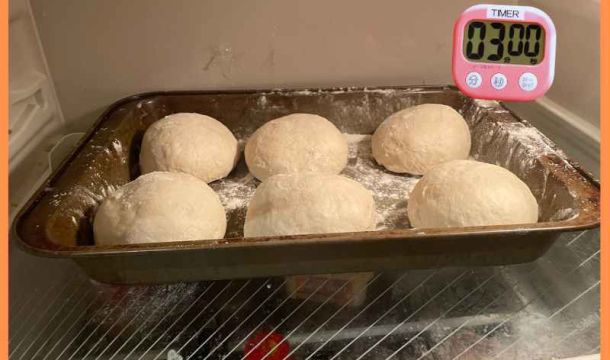Getting the best set-up for my oven at home was one of the most powerful skills I learned. It allows me to bake professional quality bread in the comfort of my home. It’s so important, I’m 99% sure it’s the biggest difference between the quality of my bread now and many other home bakers – If only I knew this stuff a few years ago!! But, guess what? It’s easy to set up your oven to make great bread. Just follow the best oven setting setup below – with a good quality baking stone. Then use the rest of the article to problem solve any issues you encounter.
- On a side note, adding water to the oven to make steam is a major part of creating optimum baking conditions. If you don't know how to do this, it isn't a problem, I have an adding water to an oven article for you to view.
What’s the best oven setting for your home oven?
Preheat a baking stone using the bottom heat only setting on the oven for 30-60 minutes at 240C (460F). Then drop the temperature to 220C (430F) when the bread goes into the oven.
The oven takes too long to heat up
The time an oven takes to heat up is down to the amount of power it can draw and the efficiency of the elements. There’s little you can do to speed up your oven without upgrading. If you notice a drop in performance, check the elements are heating correctly. You may have to replace a faulty one or repair a loose-fitting.
When you bake bread using a baking stone you need to allow extra time to get the stone to temperature. Place the stone in the oven when cold and turn on the heat. Once the thermostat indicator says it’s hot enough, give the stone a further 30-60 minutes to heat through.
You can check the temperature of the stone using an infrared thermometer. Thicker stones can take even longer than 60 minutes in some ovens.
All the steam escapes out of the oven
Bakers add steam to the oven to moisten the air. This helps the bread stretch as the bread rises in the oven and turns the crust crusty. Gas ovens can struggle with retaining the steam as they have an air hole to keep the flame alight. If you use a gas oven, I suggest using the water bath method shown in the how to add steam to an oven for bread article.
If you add steam and notice all the steam escapes out of the oven when baking bread, check that the seals are in good condition and the door shuts tight. If there is an issue, check the hinges and the door springs, you may need to readjust the fittings or tighten some screws for it to close properly.
If you follow these steps and still lose loads of steam, it is probably the pressure getting high and forcing the door to open. Professional bread ovens have strong doors that only open inwards, to compensate at home you can try to hold the door shut for a few minutes – though you’ll probably feel like a loser if someone walks into the kitchen!
My bread is pale and doesn’t rise in the oven
When bread is baked, pressure builds inside the oven. It’s caused by the moisture evaporating from the bread and any steam that has been injected. A sudden change of pressure will cause a fragile structure to collapse. Just like when the oven door is opened when making a cake or meringue. It collapses.
A change in air pressure in the first 10-15 minutes of baking can make a loaf collapse. A collapsed bread will be dense and low in volume. To prevent this from happening, hold back from opening the oven door during the first 15 minutes of baking, and check the oven seal is tight and secure. If not, replace. If you want to know more about fixing dense bread, read the why is my bread so dense article.
The oven loses heat when the door opens.
As the door is opened to load the bread, the oven loses heat. The longer it’s held open, the faster heat will escape. Try and be efficient when loading your oven so that the door is open for the shortest time possible – This can be tricky when loading a few loaves of bread at a time!
How to keep heat in the oven when baking bread
Loading the oven will lower the temperature of the oven, as does baking several products and the addition of steam – especially when cold water is used. These are the tricks I use to retain heat more heat in my oven:
- Preheat the oven for an extra 20-50 degrees higher than necessary and lower once the bread is in the correct temperature-preheat to a higher temperature for low power ovens.
- Use silicone paper or peel to put a few loaves of bread in at once.
- Bake in small batches
Perhaps the best way to keep the heat in the bread oven is to use a thick baking stone, coupled with some fire bricks and lava rocks placed in the oven. These will help your oven to stay hot after the door opens.
You get these bits from Amazon, I’ve linked my favourites below – if you decide to buy (as with the other links on the page) I’ll get a commission -without costing you any more – so thank you!
The bottom of my bread is black?!
It’s quite common to find burnt bottoms on bread when first baking bread in a home oven. Every oven works slightly different, so a little tweaking is always needed. There are a few things I’ve done for an even bake.
The first one is to get a decent baking stone. Baking stones work great to control the heat in the oven. Bakers using Dutch ovens don’t always need a baking stone, but I recommend using one if you want consistent results. A decent baking stone made with fire brick is recommended.
Putting the baking stone directly at the base of the oven transfers heat directly into the bread. This can be too hot for the bread. I’ve found it to burn the base of the loaf. It’s best to raise it using a metal oven shelf to provide some insulation.
Adjust the height of your metal oven shelf so that the top and bottom of the bread are evenly baked. If you are looking for the bread to be darker, bake at a higher temperature or turn on the top heat setting – just don’t move the shelf!
My bread collapses in the oven
Bread collapsing in the oven could be a problem with pressure leaking out of the oven – as described above. But it’s probably due to either over proofing or a lack of strength in the dough. To fix weak dough, extend the bulk fermentation period to allow the dough to mature and strengthen. Failing this, the hydration levels may be too high for the flour. To resolve, lower the water quantity or use higher quality bread flour.
Why does my bread not rise in the oven?
Bread shouldn’t do all it’s rising in the oven, it should be almost full size before going baking. If you want more spring use a preheated baking stone and add steam to the oven as the bread is baked.
What makes a good home oven for bread?
Here are ideal points, though I must point out it is pretty hard to achieve:
- A heavy door that will stay closed
- Options for bottom heat only and bottom plus top heat
- Powerful enough to heat up a baking stone and stay hot after opening
Ending thoughts on the secrets of baking bread in a home oven
We’ve covered my thoughts on how to get the most out of a home oven. What have you learned? What will you do differently in the future? Let me know in the comments below. Also, read my oven spring article to learn more about the benefits of mastering your oven skills.
If you’ve enjoyed this article and wish to treat me to a coffee, you can by following the link below – Thanks x

Hi, I’m Gareth Busby, a baking coach, head baker and bread-baking fanatic! My aim is to use science, techniques and 15 years of baking experience to help you become a better baker.
Table of Contents
- What’s the best oven setting for your home oven?
- The oven takes too long to heat up
- All the steam escapes out of the oven
- My bread is pale and doesn’t rise in the oven
- The oven loses heat when the door opens.
- How to keep heat in the oven when baking bread
- The bottom of my bread is black?!
- My bread collapses in the oven
- Why does my bread not rise in the oven?
- What makes a good home oven for bread?
- Ending thoughts on the secrets of baking bread in a home oven
Related Recipes
Related Articles
Keep up to date with the latest Articles, Recipes & Bread Baking info by joining my mailing list
Join The Weekly Bread Baker's Newsletter!
Latest Articles
Baking Categories
Disclaimer
Address
8 Woodland Avenue,
Worthing
West Sussex
BN13 3AF
UK













Leave a Reply